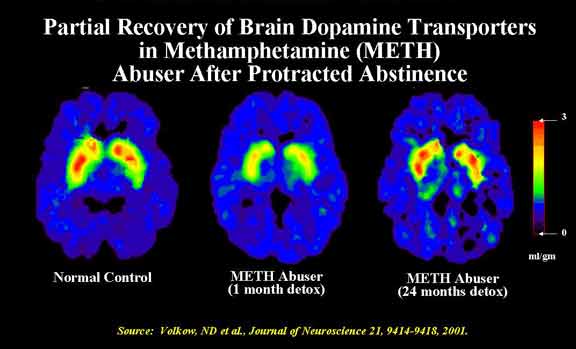Effects of Drugs On the Brain
How drugs affect brain biology
Summary:
Thebrain is a continuously changing network of connected cells
. When you learn something new or have anew experience, new connections form
. Whenever you do something that you enjoy, thereward pathway in your brain is activated
. It is that stimulation of the neurons in the reward pathway that makes you feel good by releasing chemicals which act on the pleasure centers of the brain. Drugs of abuse also activate the reward pathway and release dopamine.Repetition of dopamine release structurally alters the brain
. These alterationseventually lead to unusually strong cravings
. When the drugs are removed, thecraving-causing brain adaptations remain
.Recovery is reversing, diminishing, and coping with these brain adaptations
.Understanding the brain, to understand addiction

Since addiction is, in effect, a manifestation of what is essentially a brain malfunction, we need to first understand the brain to understand how drugs affect it. Knowing how repeated drug use and misuse can alter the brain and what the consequences of those alterations are, will help us understand what can be done to correct it. Therefore, some basic knowledge of the brain will be helpful.
How the brain works
The human brain weighs about three pounds and influences everything a person does or experiences. You may not realize it, but your brain is not the same today as it was yesterday or last month. The brain is a continuously changing network of cells. When you learn something new or have a new experience, new pathways form. Some connections get stronger, while others may weaken or even disappear. Your brain enables you to feel pleasure. Whenever you do something that you enjoy, such as eating your favorite snack, drinking a cold drink on a hot summer day, or laughing with your friends, the reward pathway in your brain is activated. It is that stimulation of the neurons in the reward pathway that makes you feel good by releasing feel-good chemicals such as dopamine.1
Opioids of abuse act on the neurons in the reward pathway. Opioids increase the release of dopamine from the neurons. The increased dopamine levels give drug abusers the rush or a high that they enjoy for a short time. The feelings of pleasure the drugs create only last a short time, but drugs can cause changes in the brain that last a very long time. Some of these physical changes may even be permanent.1
One of the changes that occurs when a person takes drugs is the development of cravings. If a person takes drugs and then stops taking them, he or she will crave the drug. In other words, the individual will have a strong desire to take more of the drug. Drugs exert such a strong effect that even the mention of drugs may stimulate cravings in drug abusers.1
Does the brain change when a person experiences cravings? PET images show that when the drug addicted patient sees the images of drugs or items associated with drugs, a part of the brain called the amygdala is activated. Because the amygdala is critical for memory functions, even stimulating a memory can trigger an uncontrollable craving for drugs.1 Addiction is classified a disease because the biology responsible for the cravings is corrupt and functioning in an unhealthy way.
On a short-term basis, drugs of abuse alter the release of dopamine. But what happens when a person takes drugs over a period of time? Does the body respond to them in the same way it did when the person tried the drugs for the first time? Often, the individual doesn't get as intense of a response after taking drugs repeatedly. This is called "tolerance." The brain has adapted to having a certain amount of the drug present and doesn't respond the same way it did initially. The body may become more efficient at metabolizing or breaking down the drug. This reduces the amount of drug in the bloodstream. Or, the cells of the body, and the brain can become more resistant to the effect of the drug by causing changes in the activity of the receptors. Tolerance explains why long term drug users take increasingly higher doses of drugs over time.1
Scientific investigations reinforce the fact that drug addiction is a brain disease. Drugs really do change the way the neurons in the brain work. This change in biology is real and must be changed or coped with, in order to control the addiction. Scientists don't know all of the answers, though. Researchers continue to investigate how drugs exert their effects. But they must deal with several issues that make answers more difficult to find. First, each person responds to drugs differently. Not everyone who experiments with drugs will become addicted. An individual's genetic makeup undoubtedly plays a part in determining whether a person becomes addicted to drugs. Second, many drug abusers abuse more than one drug. Individuals who take cocaine, for example, may also drink alcohol. Taking more than one drug at a time makes the consequences of drug abuse more unpredictable. Third, addicted people often have other health problems in addition to drug addiction. Heroin addicted people, for example, spend a lot of energy trying to obtain their drug. Their search for drugs takes over their lives. They don't eat right. They may have weak immune systems, and they often suffer from mental illnesses such as depression.1
